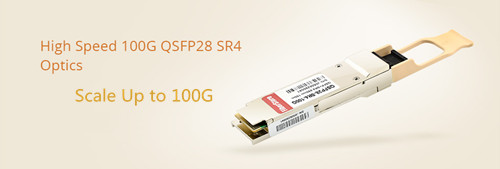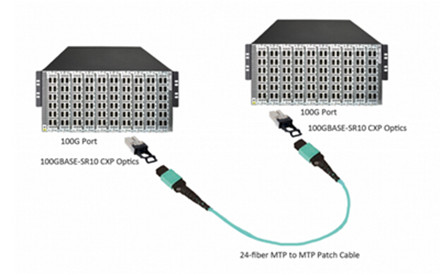Marketing
Stay For 40Gbps Network or Scale Up to 100G?
The evolution of bandwidth for data transmission is unstoppable. From the 10Mbps, 100Mbps Ethernet to the 10G or 40/100G Ethernet, telecom manufacturers keep promoting higher internet speed to facilitate people’s daily life. Now, bandwidth speeds of 1Gbps to 10Gbps Ethernet capacity are commonly utilized around the world. However, with the increase in data center and cloud computing technologies, the demand for bandwidth speeds of 40G to 100G Ethernet is growing steadily for carriers and other data consumers.
Just like the dilemma of whether to use the fiber optic cable for high performance or adopt copper cable for the low cost, these high-end data consumers also have the doubt about 40G and 100G. Should we upgrade our capacity to 40Gbps or skip 40Gbpsand migrate directly to 100Gbps Ethernet? This article will help to draw an answer to this dilemma from the aspects of market trend for required bandwidth, cost and performance.
Upgrade Straight to 100G
According to today’s market trend, the tendency is to skip 40Gbps. With demanding users peeling off multiple 10Gbps channels, the 40Gbps pipe becomes quickly utilized. Carriers scaling up to 100Gbps, allows greater flexibility for one’s network infrastructure utilizing multiplexing solutions to carve multiple bandwidth channels from a single pipe. On another scale, the same is true for the consumer market where capacity is increasing from 1Gbps to 10Gbps, skipping 2.5Gbps levels, due to the flexibility and scalability 10Gbps provides at a very similar cost. In many cases, carriers and consumers have decided to skip 40Gbps and acquire 100Gbps for the following reasons and benefits:

- Cost Efficiency—From a network equipment standpoint, often it may be more cost-efficient to upgrade a 10Gbps link to 100Gbps, versus 40Gbps. Essentially, if you should require 60Gbps or say even 80Gbps, additional cards would be needed to support the link in the chassis, whereas a customer may utilize only one card to achieve more than twice the bandwidth at 100Gbps. 100Gbps allows the network to operate within a smaller footprint of a data center, which in turn, reduces power consumption dissipating less heat and thus lower operational costs.
- Lower Latency—100Gbps provides lower latency capabilities than 40Gbps; many carrier grade vendors are lowering latency on 100Gbps matching latency of traditional 10Gbps traffic.
- Flexibility—Creates options to provide multiple variations of delivery with handoffs ranging from 10Gbps, 40Gbps or the full 100Gbps pipes.
- Scalability—Although a customer may not utilize 100Gbps on day one, the ability is there to scale the network with no forklift upgrade at any point, future-proofing the solution well beyond capacity needs.
As consumer’s demands for higher bandwidth continues to rise, many equipment suppliers, who developed some of the first 100 Gigabit Ethernet Router Interfaces, are now working on developing 200Gbps, 400Gbps up to 1 Terabyte interfaces.
This article is not implying that there is no use for 40Gbqs bandwidth level technology. Instead, I suggest that many end consumers are looking to keep up with the acceleration of high bandwidth demands while maintaining the efficiency and technologies needed to support their network infrastructure requirements while reducing operating costs.
100G Optic Solutions
FS.COM 100G transceiver solution offers customers 100 Gigabit Ethernet connectivity options for data center networking, enterprise core aggregation, and service provider transport applications. Various of 100G transceivers including CXP, CFP, CFP2, CFP4 and QSFP28 are available for different applications. The following part will lists two cost-effective 100G solutions.
- QSFP28 to QSFP28 Interconnection
The QSFP28 is the exact same footprint as the 40G QSFP+, but is implemented with four 25Gbps lanes. To interconnect a multimode QSFP28 link, a 12-fiber MPO/MTP patch cable is required, while for single-mode link (100GBASE-LR4 QSFP28), a duplex LC single-mode patch cable is required. The interconnection of QSFP28 multimode link is similar with the case of QSFP28-100G-SR4 see in the following figure.

- CXP/CFP to CXP/CFP Interconnection
FS.COM’s 24-fiber MPO/MTP assemblies are ideal for 100GBASE-SR10 CXP/CFP to CXP/CFP interconnection in data center, since it is implemented 10 lanes of 10 Gbps. Among the 24 fibers, only 20 fibers in the middle of the connector are used to transmit and receive at 10 Gbps and the 2 top and bottom fibers on the left and right are unused. The following picture shows the interconnection between two 100GBASE-SR10 CXP ports.

FS.COM provides a full selection of 100G optics including CFP, CFP2, CFP4, QSFP28 (QSFP28-100G-SR4) and QSFP28 DAC cables just as listed above. All of our products are fully compatible with the original brand. In addition, our 100G transceivers offer significant advantages over existing solutions in terms of reduced power dissipation and increased density with the added benefit of pluggability for reduced first installed cost. If you have any requirement, you can send your request to us.
Post je objavljen 12.08.2016. u 06:33 sati.